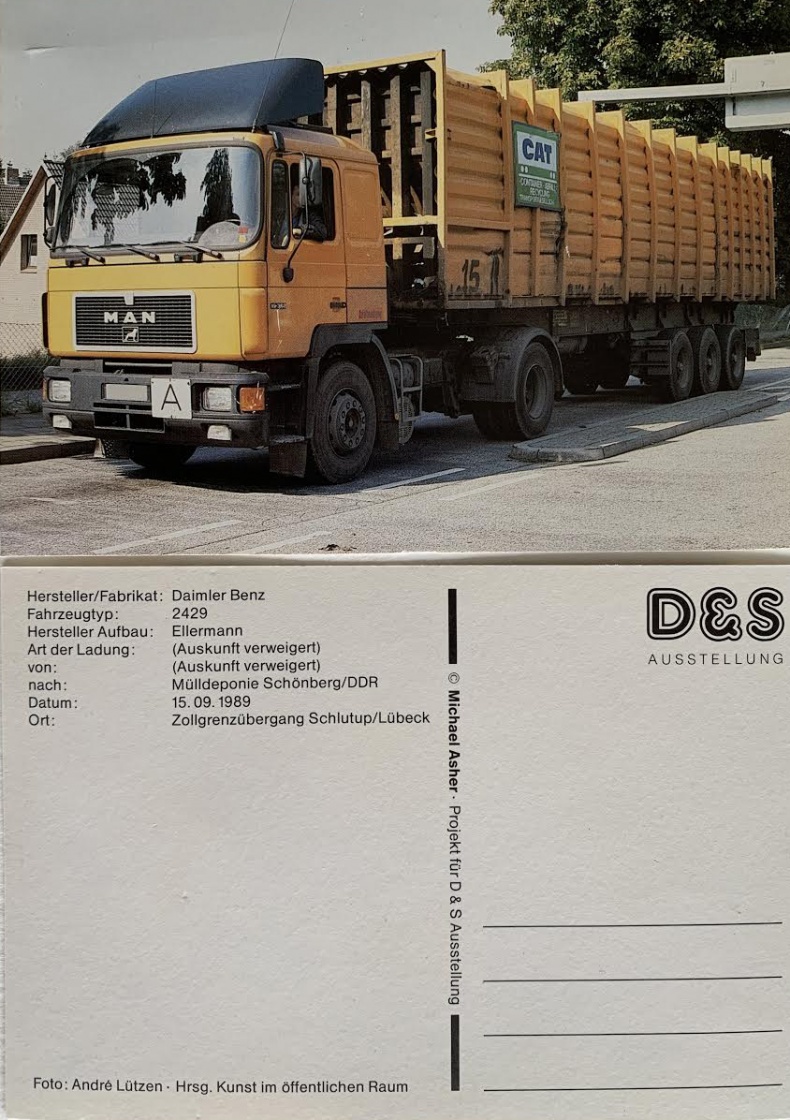Michael Asher’s Postcard Project/Projekt

December 2018
Dear Reader,
I wanted to write you a short account about eight postcards that I received from Michael Asher in the fall of 1989, when I was in my final year at CalArts completing my MFA in the Program in Art.
We met weekly in his office in the Art School. I was his TA in Post Studio Art, and we regularly discussed all kinds of things, mostly art-related. The best part of being his TA was exactly that: the one-on-one conversations with Michael, a most inspired mentor, which could go off in any direction and generally always did. In this meeting, we talked about a piece he had just finished in Germany, in which he had photographed as visual documentation numerous trash trucks suspected of hauling deeply hazardous and toxic materials from West Germany into East Germany, where the dumping of waste was less subject to regulations, if any. Printed on postcard stock, he explained, the color photos were identical to tourist postcards that one would buy as a souvenir or perhaps mail to a friend faraway. In 1989, Dear Reader, you have to remember that the wall was still up, dividing East Germany from West Germany. It may be hard to imagine today, especially if you were very young or not even born yet, how divisive and frightening the late Cold War period was in much of Central Europe. In Germany, the wall functioned as a physical barrier and a constant concrete signifier of post-WWII politics. So, Michael said, with their humble intention, these postcards sent easily and freely through the mail from someone in the West to someone in the East could succeed in revealing what had previously been covert. The postcards would identify vehicles suspected of hazardous waste trafficking and alert East German residents to be cautious of these same trucks. I recall he grinned a lot as we talked about this piece, and his glee was infectious.
Unexpectedly, at our next weekly meeting, Michael handed me a small paper envelope. Inside were all of the individual postcards, the very project that we had discussed at length the week before. All were photographed in color from the same angle; the trucks, presumably fully loaded, were depicted parked idle at the border (die Grenze) waiting to cross to the East. The back of each card identified the vehicle manufacturer, the origin of the pick-up (if known), the intended destination in the DDR (Deutsche Demokratische Republik), the contents (vague or generally not provided), the date of the photos (September 15, 1989), and the location of the border crossing, Zollgrenzübergang Schlutup/Lübeck. Commissioned in 1989, copyrighted and titled Michael Asher – Projekt für D&S Ausstellung, the postcards contain minimal additional information.
These eight postcards, intended to facilitate with a specific action on behalf of the sender, revealed the typical Michael Asher-ian humor and his unique wry wit. By keeping the postcards and not mailing them, I wonder now, did I inadvertently become a collector and possibly subvert an intended political activism? Thankfully, Michael never asked me afterwards what I did with the cards, and later that same year, in November 1989, the wall itself came down, and the world order shifted once again.
Sincerely yours,
Nicki Voss